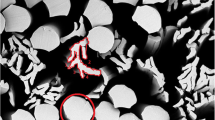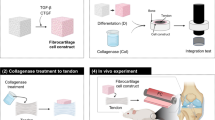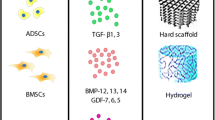Abstract
Tendon and ligament shows extremely limited endogenous regenerative capacity. Current treatments are based on the replacement and or augmentation of the injured tissue but the repaired tissue rarely achieve functionality equal to that of the preinjured tissue. To address this challenge, tissue engineering has emerged as a promising strategy. This study develops a regenerative and resorbable hybrid construct for tendon and ligament engineering. The construct is made up by a hollow poly-lactic acid braid with embedded microspheres carrying cells and an anti-adherent coating, with all the parts being made of biodegradable materials. This assembly intends to regenerate the tissue starting from the interior of the construct towards outside while it degrades. Fibroblasts cultured on poly lactic acid and hyaluronic acid microspheres for 6 h were injected into the hollow braid and the construct was cultured for 14 days. The cells thus transported into the lumen of the construct were able to migrate and adhere to the braid fibers naturally, leading to a homogeneous proliferation inside the braid. Moreover, no cells were found on the outer surface of the coating. Altogether, this study demonstrated that PLA/HA hybrid construct could be a promising material for tendon and ligament repair.







Similar content being viewed by others
References
Aktas, E., C. S. Chamberlain, E. E. Saether, S. E. Duenwald-Kuehl, J. Kondratko-Mittnacht, M. Stitgen, J. S. Lee, A. E. Clements, W. L. Murphy, and R. Vanderby. Immune modulation with primed mesenchymal stem cells delivered via biodegradable scaffold to repair an Achilles tendon segmental defect. J. Orthop. Res. 35(2):269, 2017. https://doi.org/10.1002/jor.23258.
Araque Monrós, M. C., J. Más Estellés, M. Monleón Pradas, L. Gil Santos, S. Gironés Bernabé. Process for obtaining a biodegradable prosthesis. Patent ES2392857, 2013.
Araque-Monrós, M. C., T. C. Gamboa-Martínez, L. Gil Santos, S. Gironés-Bernabé, M. Monleón-Pradas, and J. Más-Estellés. New concept for a regenerative and resorbable prosthesis for tendon and ligament: physicochemical and biological characterization of PLA-braided biomaterial. J. Biomed. Mater. Res. A 101A:3228, 2013.
Araque-Monrós, M. C., A. Vidaurre, L. Gil Santos, S. Gironés-Bernabé, M. Monleón-Pradas, and J. Más-Estellés. Study of degradation of a new PLA braided biomaterial in buffer phosphate saline, basic and acid media, intended for the regeneration of tendons and ligaments. Polym. Degrad. Stabil. 98(9):1563, 2013.
Chen, J., and G. Abatangelo. Functions of hyaluronan in wound repair. Wound Repair Regen. 7(2):79, 1999.
Costa, M. A., C. Wu, B. V. Pham, A. K. S. Chong, H. M. Pham, and J. Chang. Tissue engineering of flexor tendons: optimization of tenocyte proliferation using growth factor supplementation. Tissue Eng. Pt. A 12(7):1937, 2006.
Daniel, K. L. Achilles tendon repair with acellular tissue graft augmentation in neglected ruptures. J. Foot Ankle Surg. 46(6):451, 2007.
Deborah, P. L. The costs of musculoskeletal disease: health needs assessment and health economics. Best Pract. Res. Clin. Rheumatol. 17(3):529, 2003.
Deng, D., W. Liu, F. Xu, Y. Yang, G. Zhou, W. J. Zhang, L. Cui, and Y. Cao. Engineering human neo-tendon tissue in vitro with human dermal fibroblasts under static mechanical strain. Biomaterials 30(35):6724, 2009.
Dominkus, M., M. Sabeti, C. Toma, F. Abdolvahab, K. Trieb, and R. I. Kotz. Reconstructing the extensor apparatus with a new polyester ligament. Clin. Orthop. Relat. Res. 453:328, 2006.
Freeman, J. W., M. D. Woods, and C. T. Laurencin. Tissue engineering of the anterior cruciate ligament using a braid-twist scaffold design. J. Biomech. 40(9):2029, 2007.
García Cruz, D. M., J. L. Escobar Ivirico, M. Gomes, J. L. Gómez Ribelles, M. Salmerón Sánchez, R. L. Reis, and J. F. Mano. Chitosan microparticles as injectable scaffolds for tissue engineering. J. Tissue Eng. Regen. Med. 2(6):378, 2008.
Gaspar, D., K. Spanoudes, C. Holladay, A. Pandit, and D. Zeugolis. Progress in cell-based therapies for tendon repair. Adv. Drug Deliv. Rev. 84:240, 2015.
Iannace, S., A. Maffezzoli, G. Leo, and L. Nicolais. Influence of crystal and amorphous phase morphology on hydrolytic degradation of PLLA subjected to different processing conditions. Polymer 42(8):3799, 2001.
Iwuagwu, F. C., and D. A. McGrouther. Early cellular response in tendon injury: the effect of loading. Plast. Reconstr. Surg. 102(6):2064, 1998.
Jayasinghe, S. N., A. N. Qureshi, and P. A. M. Eagles. Electrohydrodynamic jet processing: an advanced electric-field-driven jetting phenomenon for processing living cells. Small 2:216, 2006.
Kimura, Y., A. Hokugo, T. Takamoto, Y. Tabata, and H. Kurosawa. Regeneration of anterior cruciate ligament by biodegradable scaffold combined with local controlled release of basic fibroblast growth factor and collagen wrapping. Tissue Eng. Pt. C-Meth. 14(1):47, 2006.
Krampera, M., G. Pizzolo, G. Aprili, and M. Franchini. Mesenchymal stem cells for bone, cartilage, tendon and skeletal muscle repair. Bone 39(4):678, 2006.
Kuo, C., J. Marturano, and R. Tuan. Novel strategies in tendon and ligament tissue engineering: advanced biomaterials and regeneration motifs. Sports Med. Arthrosc. Rehabil. Ther. Technol. 2(1):20, 2010.
Lao, L., H. Tan, Y. Wang, and C. Gao. Chitosan modified poly(l-lactide) microspheres as cell microcarriers for cartilage tissue engineering. Colloids Surf. B Biointerfaces 66(2):218, 2008.
Lu, H. H., J. A. Cooper, S. Manuel, J. W. Freeman, M. A. Attawia, F. K. Ko, and C. T. Laurencin. Anterior cruciate ligament regeneration using braided biodegradable scaffolds: in vitro optimization studies. Biomaterials 26(23):4805, 2005.
Mengstreab, P. Y., L. S. Nair, and C. T. Laurencin. The past, present and future of ligament regenerative engineering. Regen. Med. 11(8):871, 2016.
Molloy, T., Y. Wang, and G. A. C. Murrell. The roles of growth factors in tendon and ligament healing. Sports Med. 33(5):381, 2003.
Murray, A. W., and M. F. Macnicol. 10–16 year results of Leeds–Keio anterior cruciate ligament reconstruction. Knee 11(1):9, 2004.
Nelson, C. M., and C. S. Chen. Cell–cell signaling by direct contact increases cell proliferation via a PI3K-dependent signal. FEBS Lett. 514(2–3):238, 2002.
Nixon, A. J., A. E. Watts, and L. V. Schnabel. Cell- and gene-based approaches to tendon regeneration. J. Shoulder Elbow Surg. 21:278, 2012.
Nurettin Sahiner, X. J. One-step synthesis of hyaluronic acid-based (sub)micron hydrogel particles: process optimization and preliminary characterization. Turk. J. Chem. 32:397, 2008.
Ortuño-Lizarán, I., G. Vilariño-Feltrer, C. Martínez-Ramos, M. Monleón Pradas, and A. Vallés-Lluch. Influence of synthesis parameters on hyaluronic acid hydrogels intended as nerve conduits. Biofabrication 8(4):1–12, 2016. https://doi.org/10.1088/1758-5090/8/4/045011.
Pen-hsiu, G. C., H. Hsiang-Yi, and T. Hsiao-Yun. Electrospun microcrimped fibers with nonlinear mechanical properties enhance ligament fibroblast phenotype. Biofabrication 6(3):035008, 2014. https://doi.org/10.1088/1758-5082/6/3/035008.
Porzionato, A., E. Stocco, S. Barbon, F. Grandi, V. Macchi, and R. De Caro. Tissue-engineered grafts from human decellularized extracelular matrices: a systematic review and future perspectives. Int. J. Mol. Sci. 19(12):4117, 2018.
Roach, P., D. Farrar, and C. C. Perry. Interpretation of protein adsorption: surface-induced conformational changes. J. Am. Chem. Soc. 127(22):8168, 2005.
Townsend-Nicholson, A., and S. N. Jayasinghe. Cell electrospinning: a unique biotechnique for encapsulating living organisms for generating active biological microthreads/scaffolds. Biomacromol 7(12):3364, 2006.
Tsuji, H., K. Ikarashi, and N. Fukuda. Poly(l-lactide): XII. Formation, growth, and morphology of crystalline residues as extended-chain crystallites through hydrolysis of poly(l-lactide) films in phosphate-buffered solution. Polym. Degrad. Stabil. 84(3):515, 2004.
Vuornos, K., M. Bjorninen, E. Talvitie, K. Paakinaho, M. Kellomaki, H. Huhtala, S. Miettinen, R. Seppanen-Kaijansinkko, and S. Haimi. Human adipose stem cells differentiated on braided polylactide scaffolds is a potential approach for tendon tissue engineering. Tissue Eng. Pt. A 22(5–6):513, 2016.
Walden, G., X. Liao, S. Donell, M. J. Raxworthy, G. P. Riley, and A. Saeed. A clinical, biological, and biomaterials perspective into tendon injuries and regeneration. Tissue Eng. Pt. B 23(1):44, 2017.
Wei, X. L., L. Lin, Y. Hou, X. Fu, J. Y. Zhang, Z. B. Mao, and C. L. Yu. Construction of recombinant adenovirus co-expression vector carrying the human transforming growth factor-beta1 and vascular endothelial growth factor genes and its effect on anterior cruciate ligament fibroblasts. Chin. Med. J. 121(15):1426, 2008.
Workman, V. L., L. B. Tezera, P. T. Elkington, and S. N. Jayasinghe. Controlled generation of microspheres incorporating extracellular matrix fibrils for three-dimensional cell culture. Adv. Funct. Mater. 24:2648, 2014.
Wu, S., Y. Wang, P. N. Streubel, and B. Duan. Living nanofiber yarn-based woven biotextiles for tendon tissue engineering using cell tri-culture and mechanical stimulation. Acta Biomater. 62:102, 2005.
Acknowledgments
This work was supported by AITEX (Textil Research Institute, Alcoi, Alicante, Spain) through the researching contract “Development of braided biomaterials for biomedical applications” and also funded by AEI “RTI2018-095872-B-C21 and C22/ERDF”.
Conflict of Interest
The authors declare that they have no conflict of interest.
Ethical Approval
The authors declare that they have fulfilled ethical standards.
Author information
Authors and Affiliations
Corresponding author
Additional information
Associate Editor Michael Gower oversaw the review of this article.
Publisher's Note
Springer Nature remains neutral with regard to jurisdictional claims in published maps and institutional affiliations.
Rights and permissions
About this article
Cite this article
Araque-Monrós, M.C., García-Cruz, D.M., Escobar-Ivirico, J.L. et al. Regenerative and Resorbable PLA/HA Hybrid Construct for Tendon/Ligament Tissue Engineering. Ann Biomed Eng 48, 757–767 (2020). https://doi.org/10.1007/s10439-019-02403-0
Received:
Accepted:
Published:
Issue Date:
DOI: https://doi.org/10.1007/s10439-019-02403-0




